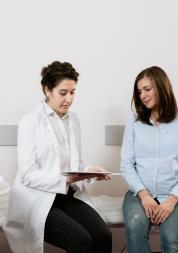Enter and View Visit to Ward 2, Springfield University Hospital

What we did
Ward 2 is a mixed 18-bed acute admissions ward for adults at Springfield University Hospital.
People between 18 and 75 are admitted when acutely unwell if their care cannot be managed in the community by the Crisis and Home Treatment Team.
The aim of the ward is to keep patients safe while they are acutely unwell and to help them return to a level of stability in which they can safely return to care in the community.
The most common diagnoses for patients on the ward are bipolar disorder, schizophrenia and personality disorder. There has been a noticeable increase in admissions of patients with personality disorder.
The team planned to:
- Identify examples of good working practice.
- Observe patients and staff and their surroundings.
- Capture the experience of patients, and relatives and visitors and any ideas they might have for change and/or improvement.
We made two main visits to Ward 2. The first, with the full team of 4 visitors, was on Thursday 8 December 2016 from 2.30 to about 5.30 pm. Our second visit to Ward 2 was on Thursday 12 January 2017 from 6.30 to about 8 pm.
Key Findings
We did not find it easy to apply our usual Enter and View methodology to the situation of an acute adult psychiatric ward like Ward 2, with its role of a last or near-last resort for people both acutely unwell and at serious risk to themselves or others.
However, at the time of our two visits, for a significant proportion of patients whom we talked to the experience of being on Ward 2 was largely disagreeable, confusing, disempowering or even frightening.
Nearly half of the patients we spoke to described their experience of the ward in negative terms such as "not good", "horrible", "unsafe" or " not the place for me". One or two experienced aspects of their time on the ward as persecutory or punitive.
On the positive side we spoke to one patient who was clearly feeling better and was able to give the ward credit for this as well as for having been given good advice on staying well.
One or two other patients implicitly recognised positive aspects of their experience of the ward in what they told us.
We looked at different aspects of being on Ward 2:
- Peace and quiet: at least two patients found the ward "noisy", another described it as "not very relaxing" and we felt these were accurate descriptions of the communal areas for part of the time we were there.
- Safety: we saw incidents of disordered, sometimes violent behaviour by individual patients, which can be distressing for other patients.
- Mixed ward: Two female patients told us of inappropriate sexual advances by male patients.
- Staff: We heard a wide spectrum of views about the ward staff. No patients seemed to be aware of having had 1:1 time with nursing staff.
- We saw little interaction between nursing staff and patients which was other than task-oriented.
- We received some mainly favourable comments about the ward's Activity Co-ordinator and the OT.
Our Recommendations
We are aware that the new ward manager for Ward 2 and her team have a programme of work in hand to further improve the quality of care and of patients' experience.
We would like to recommend that attention should be paid in particular to the following areas:
A Welcoming and supportive environment: Encourage the development of a consistently friendly and informal atmosphere on the ward, including interaction between nursing staff and patients so that all patients, even those harder to reach, may benefit from feeling listened to and able to raise any concerns.
- Develop a statement of the ward’s "philosophy of care”.
- Give the ward a name rather than a number.
- Enlarge the welcome notice at reception.
More information for patients and relatives: Improve effectiveness of procedures for distributing ward information, more notices, and letting people know about their named nurse.
Gender issues: Check whether patients have a gender preference for the professionals they work with; ensure appropriate provision for vulnerable female patients.
Noise reduction: Consider measure for noise reduction in the communal areas.
Finally, we hope that the Trust will use the advent of Service Line Management to ensure that staff working in similar wards across the Trust will increasingly be able to learn from each other and thereby spread best practice.
What happens next
Read the Trusts response to our report below:
Download the reports
If you need this report in a different format please e-mail
enquiries@healthwatchwandsworth.co.uk or call 020 8516 7767

